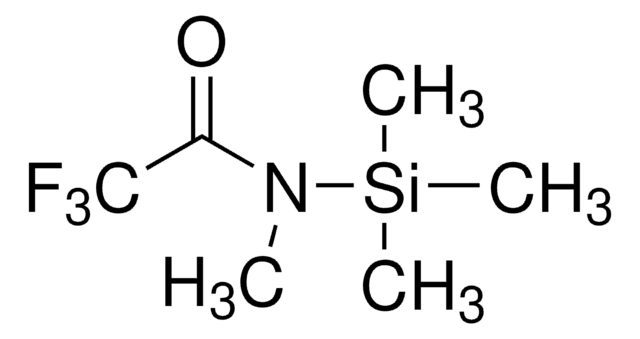M-108
MTBSTFA
with 1% t-BDMCS, ampule of 5 × 1 mL, analytical standard, Cerilliant®
Synonym(s):
N-tert-Butyldimethylsilyl-N-methyltrifluoroacetamide with 1% tert-Butyldimethylchlorosilane, N-Methyl-N-tert-butyldimethylsilyltrifluoroacetamide, MTBSTFA + 1% TBDMSCl, Silylating mixture VI
About This Item
Recommended Products
Product Name
MTBSTFA (with 1% t-BDMCS), ampule of 5 × 1 mL, (with 1% t-BDMCS), analytical standard, Cerilliant®
grade
analytical standard
Quality Level
reaction suitability
reagent type: derivatization reagent
reaction type: Acylations
packaging
ampule of 5 × 1 mL
manufacturer/tradename
Cerilliant®
technique(s)
gas chromatography (GC): suitable
application(s)
forensics and toxicology
format
neat
storage temp.
−20°C
SMILES string
CN(C(=O)C(F)(F)F)[Si](C)(C)C(C)(C)C
InChI
1S/C9H18F3NOSi/c1-8(2,3)15(5,6)13(4)7(14)9(10,11)12/h1-6H3
InChI key
QRKUHYFDBWGLHJ-UHFFFAOYSA-N
Looking for similar products? Visit Product Comparison Guide
Application
- Pharmaceutical substances in ambient particulates: A preliminary assessment.: This study explores the presence of pharmaceutical compounds in environmental particulate matter, using analytical methods that could involve derivatization agents like MTBSTFA. The detection of these substances in air samples suggests potential health impacts and environmental persistence (Cecinato et al., 2017) (Cecinato et al., 2017).
Legal Information
related product
Signal Word
Warning
Hazard Statements
Precautionary Statements
Hazard Classifications
Eye Irrit. 2 - Flam. Liq. 3 - Skin Irrit. 2
Storage Class Code
3 - Flammable liquids
WGK
WGK 3
Flash Point(F)
113.0 °F - closed cup
Flash Point(C)
45 °C - closed cup
Choose from one of the most recent versions:
Certificates of Analysis (COA)
It looks like we've run into a problem, but you can still download Certificates of Analysis from our Documents section.
If you need assistance, please contact Customer Support.
Already Own This Product?
Find documentation for the products that you have recently purchased in the Document Library.
Customers Also Viewed
Our team of scientists has experience in all areas of research including Life Science, Material Science, Chemical Synthesis, Chromatography, Analytical and many others.
Contact Technical Service





